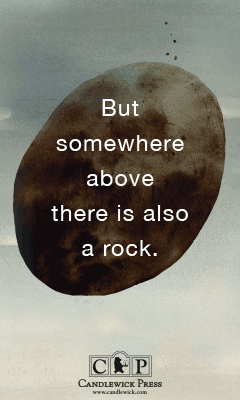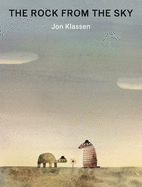The Rock from the Sky
by Jon Klassen
In his fourth solo picture book, Caldecott Medalist Jon Klassen (This Is Not My Hat) offers readers a collection of five bite-size, hilariously deadpan stories centered around a massive, mysterious rock that falls from the sky. Enacted by his trademark dot-eyed animals in hats, each brief comedy hews to the sly, cheeky sense of humor and precise timing readers have come to recognize as a hallmark of Klassen's work.
The titular stone looms into view even before the title page, an ominous, archetypal boulder mottled black and gray like a storm cloud. The first, longest story, "The Rock," opens on a lone pink flower standing on flat land against a softly lit horizon. A turtle in a black bowler hat walks onto the page and stands by the flower, both animal and plant made tiny by the massive dusky blue-gray sky. The turtle proclaims the spot its favorite, adding, "I don't ever want to stand anywhere else." With the page turn, readers realize the rock seen earlier is hurtling through the sky toward an unknown target. The turtle is joined by a long-snouted, banded animal. This creature from Klassen's imagination--not quite an armadillo, not quite a mole--also wears a black bowler. The armoledillo agrees to share the turtle's spot but soon gets a bad feeling about it and finds another spot, all the way across the double-page spread, next to a green shoot. The turtle, now a significant distance away from its friend, yells, "HOW DOES THAT SPOT FEEL?" Unable to hear across the expanse, the armoledillo walks back to the turtle, who asks, "Does this spot still feel bad?" The armoledillo, the whites of its eyes huge around the black dot pupil, responds, "Yes. It feels even worse than before. I am going back to the other spot." By this time, readers will likely realize the rock--which continues its descent--is plummeting toward one of the spots. But which one? A brown snake with triangular markings and a black beret arrives on the scene. "Oh, hello. I am standing in this spot by myself," the armoledillo says. "Come. Stand in it with me." The turtle, perhaps jealous, shouts, "MY SPOT IS BETTER." Again, the armoledillo cannot hear. Klassen uses the suspense of the page turn to demonstrate the turtle's slow pace--"I AM COMING CLOSER"--by giving it two page turns to walk to its companions: "I said my spot is better." The next page turn shows the massive egg-shaped rock crashing to earth and obliterating the pink flower. Klassen, with his keen sense of how to make the greatest impact, ends the story there. The animals stare at the rock in pop-eyed, silent horror, a laugh-out-loud hilarious tension breaker punctuating a near-tragedy.
The four stories that follow "The Rock" build on it and each other, using the boulder as a set piece. In "The Fall," the reader sees the turtle fall from the rock and land on its shell. When offered help by the armoledillo, it insists, "I never need help." Tables turn when the turtle suggests a nap and the armoledillo claims, "I am never tired." While children may not recognize themselves in these refusals, caregivers will likely see the parallels and chuckle. In the surrealist outing "The Future," the turtle and armoledillo get more than they bargained for when they lose control of their own imagined scenario and summon a terrifying creature. This story might speak to a small child's capacity for boundless imagination and how that couples with an incomplete comprehension of the scope of reality. "The Sunset" finds the turtle unwittingly racing the sun to find out why the snake and armoledillo are sitting under the rock.
"No More Room," the final entry, ties the collection together in side-splitting fashion. In a fit of jealous pique, the turtle storms to the second spot after finding the snake and armoledillo snoozing together in the spot with the rock. The resolution remixes the recurring gags of not hearing each other across the distance and the turtle's slow pace with a cameo from "The Future" monster and a deus ex machina resolution far too funny to spoil.
Klassen's signature minimalist sensibilities rule each episode, his muted palette and deceptively understated character design lending sophistication while also supporting young readers who are still developing visual literacy skills. With so little visual noise, actions come through clearly. The same philosophy of restraint applies to body language and expression; characters communicate their entire range of emotion through the position of their dot pupils and how widely they open their eyes. The two-dimensional setting, with its flat ground and vast sky, suggests readers are watching the action unfold on a stage with the proscenium arch removed. Klassen seems to relish getting big laughs through small nudges, and much of the humor relies simply on blocking. Absent a narrator, each episode takes context solely from dialogue between the turtle and armoledillo, their lines differentiated by black and gray text respectively. Its simple sentence structure offers emerging readers a foothold for enjoying it independently.
Safe scares, sight gags and a healthy respect for readers' abilities to read between the lines make The Rock from the Sky a rare treat. Since Klassen tends to work collaboratively more often than alone, the release of five of his stories in a single volume feels like an embarrassment of riches. Adults will want to make a point of sharing this savvy and creative assortment with their young readers, or perhaps with other grownups who appreciate a masterpiece of well-executed dry humor. --Jaclyn Fulwood








